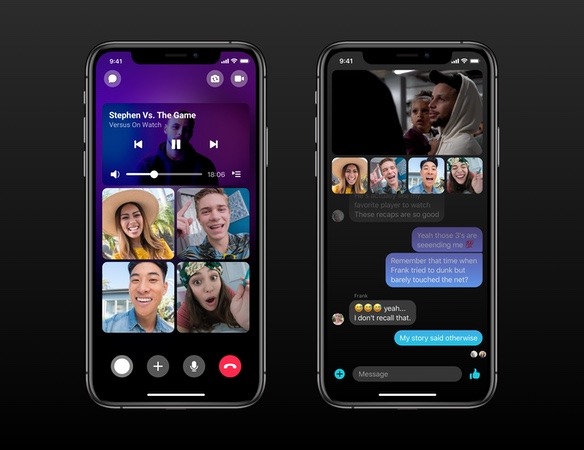
The traditional SMS text message is now old-fashioned, particularly with the explosion of popular, easy-to-use Android messaging apps. WhatsApp, Telegram, Send, Line and other apps all offer free text messaging over the internet. And that’s not even mentioning the options for voice, video, and file-sharing to other users.
Mobile messaging apps let you send text messages, share photos, videos and even make voice and video calls while avoiding SMS and call charges. Here are more than a dozen different options that give you new ways to stay in touch with friends, family, and business contacts.
Best Android Messaging Apps For Texting
We’ve rounded up the 10 best Android messaging apps that you should start using now.
1. Facebook Messenger
Facebook’s own foray into the mobile messaging field is Facebook Messenger (Android, iOS), a dedicated messaging app that builds on Facebook’s chat network and adds more mobile messaging features as well as extensions and add-ons.

Users sign in via Facebook and can send other users the usual chat messages, as well as voice messages and voice and video calls to other Messenger users, with extra features like GIF support and photo and location sharing.
2. Chomp SMS
The Chomp third-party texting app is extremely comprehensive and now has over 10 million users. One of the features is a scheduled SMS sender, so you won’t miss those important occasions, and further features include emojis, privacy options, a passcode app lock, blacklisting with an SMS blocker, MMS, signatures, dual SIM support, group messaging and more.

If you’ve ever pressed the ‘send’ button and immediately regretted it, you’re covered with this app as you can stop a text while it’s in the sending process.
3. Blackberry Messenger Enterprise
It may be time to say goodbye to the consumer version of BlackBerry Messenger, but BlackBerry’s messaging platform is not quite dead yet. A secured version of the messaging app, BBM Enterprise (Android), is also available, with less social frills and a higher focus on security and collaboration features.

Users can engage in group or 1-on-1 chats (along with read receipts), and edit, retract, or delete messages, or set them to self-destruct.
4. PushBullet
This highly-rated app enables you to send and receive SMS messages on your computer. That’s a real advantage at times, as it can be much easier to use a computer keyboard than the one on your phone.

You can also use PushBullet to reply to messages from other apps that include Facebook Messenger, WhatsApp, and Kik, as well as sharing links and files with friends or between your devices.
5. WhatsApp
Remarkably easy setup, automatic syncing with your phone’s contacts and a feature-rich, ad-free experience all combine to make WhatsApp a wildly popular mobile messaging app.

Users can send text, photos, voice and short video messages to their WhatsApp contacts, and the app has continuously added new features to its toolkit, such as emoji, and fully encrypted messaging between WhatsApp users. Recent additions include a group chat feature where only admins can send messages.
6. Viber
Viber is easy to set up and still offers a variety of options, even as version 10 of the chat app hits mobile app stores. This app uses your phone number as your login, and the app syncs with your phone to help you find Viber-using contacts.

You can use this app to send text, stickers and emoticons, photos, voice and video messages for free to other users. The Out feature lets you call non-Viber numbers and landline phones worldwide (for a fee).
7. Microsoft Teams
Of course, if your company already takes advantage of Microsoft’s Office 365, then you could do just as well with Microsoft Teams, the tech giant’s own productivity-oriented app.

Teams offer a rich set of features, from your basic group chats, chat channels. It also supports organization tools to video and voice calls and file sharing.
8. Slack
Productivity and team-oriented messaging app Slack has been a hit for corporations and casual users alike with its mix of messaging, scheduling, management tools, and app integration.

Slack covers your IM basics with real-time messaging synced across devices. It also supports file sharing, direct and group messaging tools. In addition, the app features a system of chat channels. These channels allow you to quickly set up subgroups for task or topic-oriented discussions.
9. BAND
For a messaging and collaboration app that’s less formal and business-like, check out BAND, a group chat and coordination platform that’s designed for more informal groups like friends, family, study groups or your neighborhood sports team. Users can create custom groups and invite their friends.

A broadcasting general announcements can be done through a community board while also providing more focused private chats.
10. Signal
Open Whisper Systems Signal is another fantastic messaging solution for security-conscious mobile users. With Open Whisper Systems’ messaging and RedPhone and TextSecure, Signal is an all-in-one messaging and voice call solution.

It uses end-to-end military-grade encryption.
Top 15 Android Messaging Apps
- Facebook Messenger
- Chomp SMS
- Blackberry Messenger
- Push Bullet
- WhatsApp Messenger
- Viber
- Microsoft Teams
- Slack
- Band Messenger
- Signal Private Messenger
- QKSMS – Open Source Messaging App
- SnapChat
- Flychat Messenger
- Google Allo Messaging App
- Go SMS Pro
Final Verdict
There is such an assortment of messaging app available on the Google Play Store, it has been no mean feat narrowing them down to these top choices. These apps will all offer a good experience, and some are basic while some offer additional features.
If you try out any of these Android messaging apps, we’d like you to share your thoughts by giving a comment. Additionally, if you think we’ve missed any messaging app, let us know your own recommendations.













